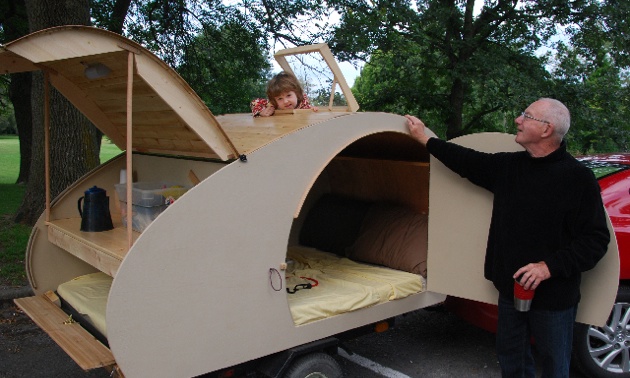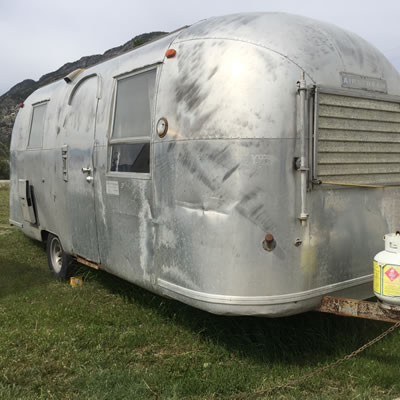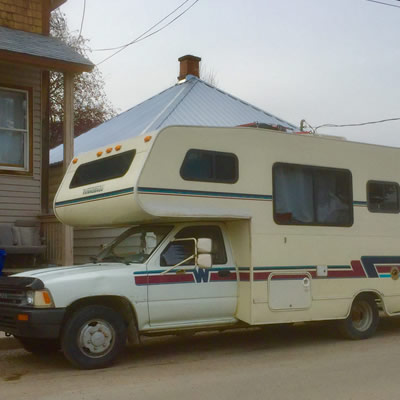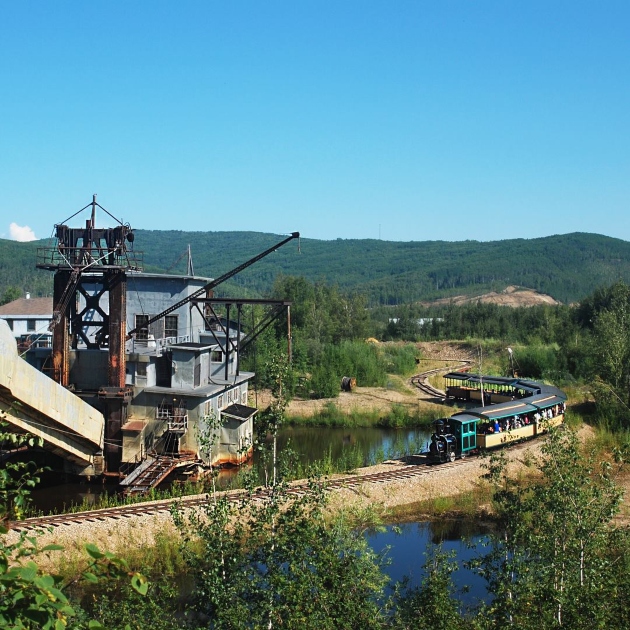Building a retro RV with only a photo
Kate Jaimet's dad, Jim Jaimet, put his years of woodworking to the test and created a teardrop-shaped wooden trailer this summer

Dad filled my childhood with the whiff of sawdust and the ring of hammer on nail.
Seldom did a Saturday morning go by without the familiar phrase passing his lips: “Kate, I’ve got a two-man job.” Soon I’d be running to his workshop to fetch a screwdriver, or grasping the split ends of a pine board as they emerged from the roaring, whirling teeth of his table saw.
I must have been the only kid in my Grade 2 class who knew the difference between a Phillips and a Robertson.
Retirement has given Dad lots of time to pursue his woodworking. He’s gone beyond the utilitarian fences, decks and home reno jobs that filled his working years to branch into cabinetry—crafting coffee tables, armchairs and even a king-sized bed as a gift on my wedding day. But this summer, he outdid himself.
This summer, Dad built a retro-style camper trailer.
“Kate, let me show you something neat,” Dad said one Saturday afternoon, as he stood in flip-flops and Bermuda shorts, grilling hamburgers on his back patio. (Dad enjoys living up to the image of the suburban retiree.)
He pulled his cellphone from his pocket and brought up a photo of a 1950s-style teardrop trailer that he’d downloaded from the Internet. It was small, bubble-shaped, and—but for a coat of blue paint—it looked like it could have come off the assembly line at Smurf Automotive.
Come to think of it, with his septuagenarian growth of white stubble, Dad was starting to look a bit like Papa Smurf.
Most importantly, from Dad’s point of view, the trailer was made of wood.
“I’m going to build one,” Dad announced.
“Wow,” I said.
Over the years, I’ve found “wow”—an expressive yet ambiguous monosyllable—to be a useful response to Dad’s more hare-brained schemes.
“Did you download the plans?” I asked.
“Plans? Pish!” Dad waved his hand with the nonchalance of a lifelong do-it-yourselfer whose motto is Step 1: Throw out the instructions.
“There are no plans!” Dad scoffed. “All I have is this photo.”
The photo—and a workshop crammed with power tools. What more did a handyman need?
Over the summer, I checked in periodically on the progress of the camper. At first, there was a lot of humming and head-scratching coming from Dad’s workshop, but by and by the first piece of the camper appeared: a square wooden frame with a pane of glass in the middle. The skylight.
It might be said that Dad was starting in his comfort zone. After all, over the decades he’d built innumerable square, wooden things. But I preferred to think that he was employing the artistic concept of negative space: building the camper around the hole in its top.
Soon, Dad’s workshop buzzed with full-blown construction. The teardrop-shaped sides emerged, cut from huge sheets of plywood. Then came the flat base of the camper. The platform for the bed. Shelves to hold cooking implements and a Coleman stove.
Occasionally, Dad would hit a stumbling block, his powers of invention taxed by the complexities of the curvilinear construction.
“How are you going to build the roof?” I asked one day as I stood amidst the dancing sawdust motes in the workshop, dutifully admiring the half-finished contraption.
“Your beer looks awfully low, Kate. Let me get you a refill,” Dad replied.
But the years of woodworking stored in his brain—the untold millions of angles measured, boards ripped, grooves routed, screws driven, holes drilled and joints mitered—always provided a solution. And finally, one fine day in August, Dad pulled up to the curb outside my house towing the trailer.
What can I say? It was as though all of Dad’s artistry and ingenuity had been encapsulated into a two-wheeled cedar pod. An ovoid door opened to reveal the sleeping area, while a back hatch lifted to expose the compact kitchen. The interior was illuminated by two small ceiling lights powered by tiny solar panels fixed to the roof.
“Wow,” I said.
“I’m taking it on the road,” Dad announced. First he’d make a short jaunt to Toronto via Minden, Ontario. After that, who knew? Maybe he’d take it for a ski holiday in the Rockies.
“Is it heated?” I asked dubiously.
A gleam came into Dad’s eye, like sunlight glinting on a steel saw blade.
“Heated?” he said. “Pish! It shouldn’t be hard to rig up a little heating system . . .”
So if, on your travels, you should happen to see a car towing a bubble-shaped piece of summer whimsy around, that isn’t Papa Smurf at the wheel—it’s my dad. Give him a wave, maybe stop to chat. He’d be happy to give you a few tips on how to build your own.
After all, with a shop full of power tools and a head full of ingenuity, a little summer whimsy can go a long, long way.
Share your classic RV restorations, or tell us your favourite story about a cool vintage unit you've encountered by filling out our Classic Vintage RV form.








